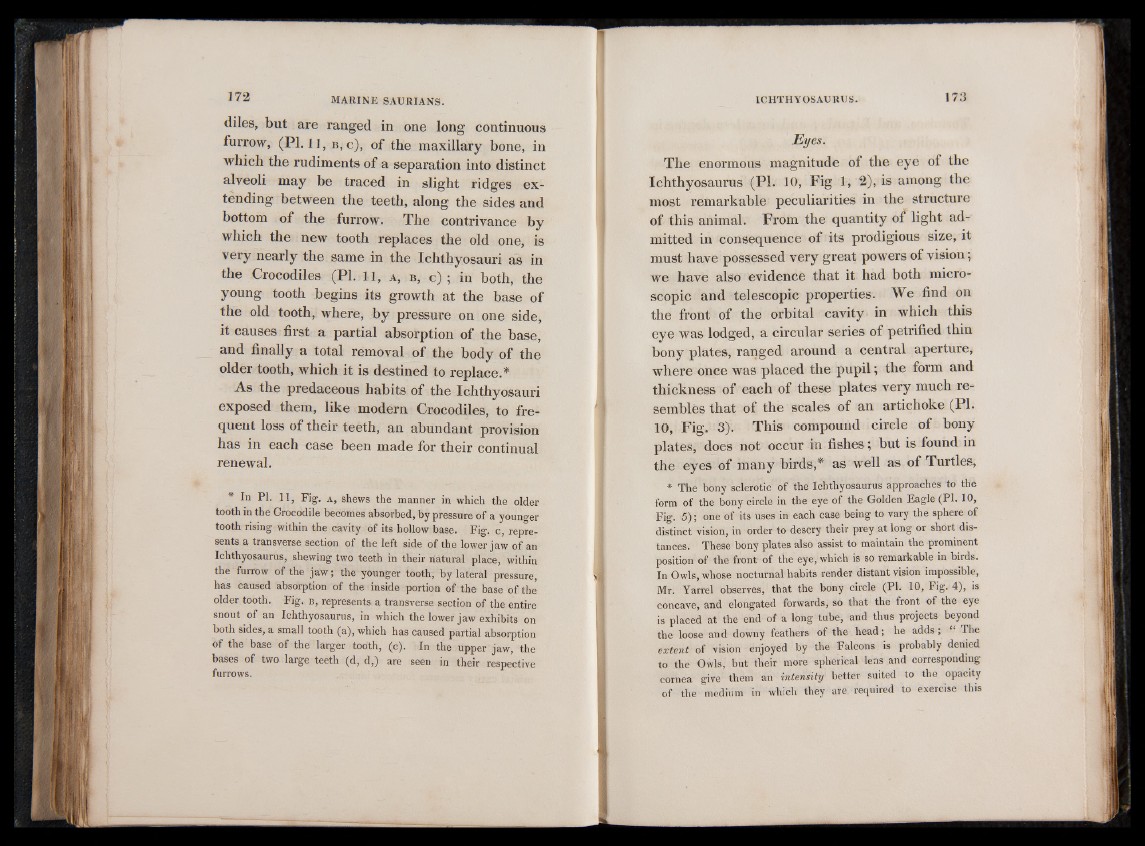
diles, but are ranged in one long continuous
furrow, (PI. 11, b, c), of the maxillary bone, in
which the rudiments of a separation into distinct
alveoli may be traced in slight ridges extending
between the teeth, along the sides and
bottom of the furrow. The contrivance by
which the new tooth replaces the old one, is
very nearly the same in the Ichthyosauri as in
the Crocodiles (PI. 11, a, b, c) ; in both, the
young tooth begins its growth at the base of
the old tooth, where, by pressure on one side,
it causes first a partial absorption of the base,
and finally a total removal of the body of the
older tooth, which it is destined to replace.*
As the predaceous habits of the Ichthyosauri
exposed them, like modern Crocodiles, to frequent
loss of their teeth, an abundant provision
has in each case been made for their continual
renewal.
* In PI. 11, Fig. a , shews the manner in which the older
tooth in the Grocodile becomes absorbed, by pressure of a younger
tooth rising within the cavity of its hollow base. Fig. c, represents
a transverse section of the left side of the lower jaw of an
Ichthyosaurus, shewing two teeth in their natural place, within
the furrow of the jaw ; the younger tooth, by lateral pressure,
has caused absorption of the inside portion of the base of the
older tooth. Fig. b , represents a transverse section of the entire
snout of an Ichthyosaurus, in which the lower jaw exhibits on
both sides, a small tooth (a), which has caused partial absorption
of the base of the larger tooth, (c). In the upper jaw, the
bases of two large teeth (d, d,) are seen in their respective
furrows.
Eyes.
The enormous magnitude of the eye of the
Ichthyosaurus (PI. 10, Fig 1, 2), is among the
most remarkable peculiarities in the structure
of this animal. From the quantity of light admitted
in consequence of its prodigious size, it
must have possessed very great powers of vision;
we have also evidence that it had both microscopic
and telescopic properties. We find on
the front of the orbital cavity in which this
eye was lodged, a circular series of petrified thin
bony plates, ranged around a central aperture,
where once was placed the pupil; the form and
thickness of each of these plates very much resembles
that of the scales of an artichoke (PI.
10, Fig. 3). This compound circle of bony
plates, does not occur in fishes; but is found in
the eyes of many birds,* as well as of Turtles,
* The bony sclerotic of the Ichthyosaurus approaches to the
form of the bony circle in the eye of the Golden Eagle (PI. 10,
Fig. 5); one of its uses in each case being to vary the sphere of
distinct vision, in order to descry their prey at long or short distances.
These bony plates also assist to maintain the prominent
position of the front of the eye, which is so remarkable in birds.
In Owls, whose nocturnal habits render distant vision impossible,
Mr. Yarrel observes, that the bony circle (PI. 10, Fig. 4), is
concave, and elongated forwards, so that the front of the eye
is placed at the end of a long tube, and thus projects beyond
the loose an d downy feathers of the head; he adds; ‘ The
extent of vision enjoyed by the Falcons is probably denied
to the Owls, but their more spherical lens and corresponding
cornea give them an intensity better suited to the opacity
of the medium in which they are required to exercise this